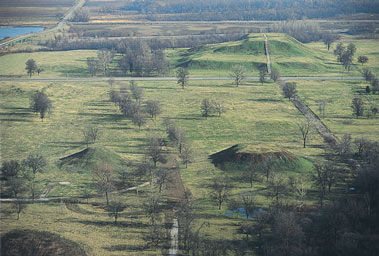
This Article From Issue
November-December 2002
Volume 90, Number 6
DOI: 10.1511/2002.39.0
Cahokia: Mirror of the Cosmos. Sally A. Kitt Chappell. xx + 218 pp. University of Chicago Press, 2002. $38.00.
Cahokia was a major New World city in the 10th through the 13th centuries. With perhaps 20,000 residents, it was probably more populous than London. Pyramids and platforms ringed its huge central plaza, the largest rising 30 meters from a base covering almost 6 hectares. A bastioned wall surrounded the ceremonial core of the city, around which thousands of homes formed neighborhoods. Cahokia's citizens imported art and rare objects from distant lands. Its scientists studied the heavens and their geometry, and its architects built their city on the principles those scientists discovered. Its priest-kings were buried with pomp, treasure and dozens of sacrificed men and women. Cahokia was a very great city indeed.
Where is this remarkable ruin? In Mexico? Guatemala? Peru? No, it sits right across the Big Muddy from the Gateway Arch of St. Louis, in Collinsville, Illinois (from I-55, take exit 6 and you're there). Cahokia was the largest and most cosmopolitan city ever to exist in the territory that was to become the United States, but most of us have never heard of it.

From Cahokia.
Archaeologists have poked and prodded the site for more than a century. They call Cahokia's earthen monuments mounds and its builders Mississippians. This group transformed much of the Mississippi Valley and the Southeast with their culture. A renaissance in Mississippian studies is now under way and has been accompanied by new interest in the preservation of Cahokia and the presentation of its artifacts.
Many archaeological discoveries were made at Cahokia in the 1960s and 1970s. The state of Illinois acquired surrounding land and created Cahokia Mounds State Historic Site. In 1989, the Cahokia Mounds Museum Society opened a new Interpretive Center there, which incorporates some of the old house foundations, preserving them and their artifacts in situ. The site is a remarkable place—a "must see" for those interested in Native American history. (For online information, see www.cahokiamounds.com)

From Cahokia.
Sally A. Kitt Chappell's Cahokia: Mirror of the Cosmos is a highly readable, elegantly produced introduction to the site, with 128 illustrations, many in full color. Chappell, professor emerita in the art department of DePaul University, is an architectural historian. Her title page names as "consultants" William R. Iseminger and John E. Kelly, both highly regarded archaeologists in this field. The book, however, is not intended as a technical synthesis of Cahokia archaeology. (For that, see George R. Milner's The Cahokia Chiefdom, Smithsonian Institution Press, 1998; or wait for Timothy R. Pauketat's forthcoming Ancient Cahokia, Cambridge University Press, 2003.)
Chappell's writing is lucid and humanistic—Cahokia is not a science book—and her scope is broad: She starts with the Big Bang and pictures of deep space and ends with an account of the current status of the site. Chapters cover Cahokia's natural setting (with maps of the geology, soils and vegetation, which are odd for the western edge of the Prairie State); pre-Cahokia archaeology of the Paleo-Indians, Archaic Amerindians and Woodland people; Cahokia's earth architecture; and the history of the site from Colonial times to the present.
This material is interesting, useful and well presented, but the book as a whole seems curiously distant from the goings-on of ancient Cahokia. Only 25 of the 191 pages of text describe the archaeology of the site itself. The city was in decline by 1300 A.D. and abandoned by 1400, yet more than half the book covers events from 1672 to 1997. Thus the site is presented more as a very interesting ruin—a place important in many people's histories—than as the mirror of an aboriginal cosmos. It's true that historic and contemporary encounters with vestiges of the great city are of considerable humanistic, historic and philosophical interest. (See, for example, Roger G. Kennedy's account of Moundbuilders and early American political thought in Hidden Cities, Free Press, 1994.)
Readers seeking a first introduction to the site, its ancient peoples and its role in the evolution of human societies in North America may be less interested in its post-Colonial history. Casual readers focused on the city may do as well with the handsome 76-page pamphlet Cahokia: City of the Sun (Cahokia Mounds Museum Society, 1992), which was written by Claudia G. Mink and edited by Chappell's consultant Iseminger; it has many of the same color illustrations as Chappell's book.
Cahokia: Mirror of the Cosmos is a worthy appreciation of the great city and the people who built it and ruled it; it provides context and history not available in some more focused accounts of the ancient culture. For anthropological archaeologists and social scientists, the book offers insight into the humanistic appreciation of ancient times and archaeology. Study of the remote past does not belong exclusively to scientists, who would do well to attend to this respected architectural historian's scholarship and interpretation.—Stephen H. Lekson, Anthropology and Museum of Natural History, University of Colorado, Boulder
American Scientist Comments and Discussion
To discuss our articles or comment on them, please share them and tag American Scientist on social media platforms. Here are links to our profiles on Twitter, Facebook, and LinkedIn.
If we re-share your post, we will moderate comments/discussion following our comments policy.